The Autumn Leaf (Doleschallia bisaltide)
An Autumn Leaf ssp ? bisaltide var feeding at the yellow cultivar of Lantana camara
We continue with our Butterfly of the Month (BOTM) series into its 16th year featuring our local butterfly species extant in Singapore. Starting with this new 2023 series, will be a side discussion on the twelve astrological zodiac signs for each month of the year till December 2023. The astrological signs are Aries, Taurus, Gemini, Cancer, Leo, Virgo, Libra, Scorpio, Sagittarius, Capricorn, Aquarius, and Pisces.
Astrology is a pseudoscience. There appears to be no scientific validity or substantiation of the theoretical basis and verification of claims or conclusions of the characteristics of human behaviour or traits that are associated with each zodiac sign. More plausible explanations for the apparent correlation between personality traits and birth months exist, such as the influence of seasonal birth in humans.
The Western zodiac originated in Babylonian astrology, and was later influenced by the Hellenistic culture. Each sign was named after a constellation the sun annually moved through while crossing the sky. This observation is emphasized in the simplified and popular sun sign astrology. Astrology (i.e. a system of omina based on celestial appearances) was developed in Hindu, Chinese and Tibetan cultures as well - each with its own interpretation, measuring and dividing the sky are currently used by their respective differing systems of astrology.
We start with the zodiac sign Capricorn (or Capricornus). Its name is Latin for "horned goat" "having horns like a goat's", and it is commonly represented in the form of a sea goat: a mythical creature that is half goat, half fish, with the head of a goat and the tail of a fish. In astrology, Capricorn is considered an earth sign, negative sign, and is said to be ruled by the planet Saturn.
An Autumn Leaf ssp ? bisaltide var feeding on the flower of Syzygium sp.
Capricorn is the tenth astrological sign in the zodiac. People born between and including December 21 to January 19 belong to this zodiac sign. It is symbolized using the animal ‘goat’ and describes those people who are built for hard work. They are very disciplined, law-abiding and are good managers especially of themselves. They are perfectionists guided by logic and loyal and dependable. However, they are likely to tire themselves out at some point and they can also be rigid and sometimes viewed as obstinate.
Our first Butterfly of the Month for the year 2023 is the Autumn Leaf (Doleschallia bisaltide). The Autumn Leaf occurs in two different subspecies in Singapore, ssp ?bisaltide var.and ssp pratipa. The dominant subspecies, first discovered in Singapore in the early 2000's, is the more common taxon in Singapore, and has moved northwards as far as Selangor in West Malaysia. The peninsular Malaysian subspecies pratipa was last reliably recorded at the Mandai Zoo where an ovipositing female was observed in the wild and the eggs bred to adulthood.
Autumn Leaf ssp pratipa ovipositing on one of its caterpillar host plants at the Mandai Zoo
Caterpillar of Autumn Leaf ssp pratipa
Female Autumn Leaf ssp ?bisaltide var.
Although the dominant subspecies in Singapore differs from ssp pratipa in having five small white spots on the black apex of the forewing above, it is difficult to separate the two subspecies in the field. However, their caterpillars show significant difference in the orange-red spots at the base of the lateral scoli in ssp ?bisaltide var. and are absent in ssp pratipa.
The upperside of the Autumn Leaf is orange-brown with the forewing apex broadly blackened. The subspecies ?bisaltide var. features the prominent five small subapical white spots on the forewing above, which is absent in subspecies pratipa. The underside is highly variable with the ground colour ranging from greyish-brown to mauve-brown. The patterns on the underside are so variable that it is not easy to find two specimens which are completely identical markings.
Underside of a male Autumn Leaf ssp ?bisaltide var
Males of the subspecies ?bisaltide var. feature large prominent white spots on the underside of both wings, whilst females are generally more orange-brown with less distinct markings. The leaf-like pattern of the underside of the Autumn Leaf is an excellent camouflage. The tornus of the hindwing is produced to a tail, resembling a leaf stalk, and when the butterfly is at rest with closed wings amongst dead foliage, it is hard to spot.
Upperside of a male Autumn Leaf ssp ? bisaltide var puddling at a sandy streambank
The Autumn Leaf has a strong flight, and is usually skittish and hard to approach. However, it is often observed feeding at flowers. Males are also regularly seen puddling at muddy footpaths and damp sandbanks where they can be approached for a closer look. As with most species of the Nymphalidae family, the forelegs are underdeveloped and the butterfly perches on the mid- and hind legs.
The caterpillars of both subspecies feed on a variety of host plants, ranging from Asystasia gangetica (Acanthaceae), Pseuderanthemum laxiflorum (Acanthaceae), Pseuderanthemum carruthersii var. reticulatum (Acanthaceae), and is likely to feed on other host plants in the Acanthaceae family as well. The status of the two subspecies is a good potential for further taxonomic and genetic research to establish with greater clarity in future.
Text by Khew SK : Photos by Khew SK, Loh MY, Loke PF, Horace Tan and Anthony Wong

















